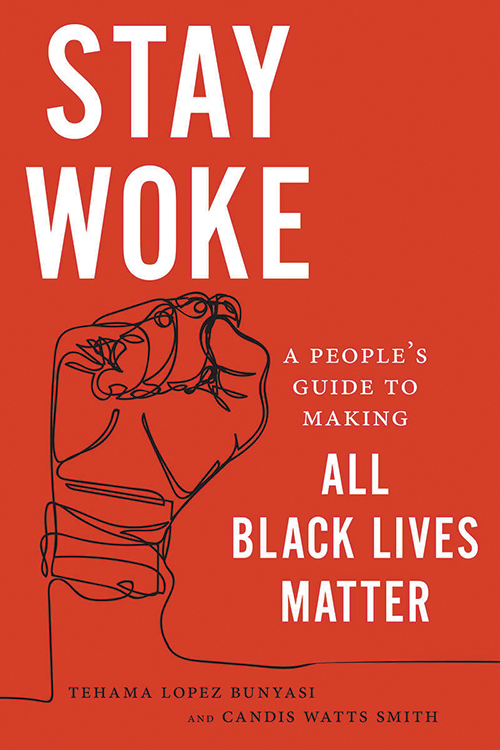
Stay Woke: A People’s Guide to Making All Black Lives Matter
Reviewed by Patience Schenck
September 1, 2020
By Tehama Lopez Bunyasi and Candis Watts Smith. New York University Press, 2019. 288 pages. $89/hardcover; $18.95/paperback.
This is the book I wanted to write almost 20 years ago when I first felt called to antiracism work. (I didn’t appreciate then how little I actually knew.) But I soon discovered just how resistant, defensive, and incurious most White people—my intended audience—were about race.
That was then. I write while protests against racism are filling the streets. Today I dare hope that many more people are ready to learn about the violence of racism in America and to address it.
Stay Woke is a good primer if you don’t know very much about how race operates, and even if you are fairly knowledgeable, it will update you. The book revolves around the contemporary Black Lives Matter (BLM) movement. It shows how the movement is shifting toward valuing all people, including many left behind by the Civil Rights Movement, such as Black gay people and Black people with criminal records.
The authors begin with a description of meritocracy and the American dream, both myths taught to all children in the United States. Kids are told that if they work hard, they can be successful. Our schools do not teach them about racism, poverty, militarism, and materialism, leaving them to think that if some people don’t achieve the dream, it must be their fault. The authors show how the uneven distribution of resources plays out in criminal justice, housing, education, employment, and health. They describe criminal justice practices aimed primarily at people of color. In answer to accusations that Black-on-Black crime incriminates Black people, they point out that most White crimes are White-on-White.
The second chapter is a glorified glossary. Some entries help us adopt common understandings of terms (e.g., racism and diversity). Others have helped me be more in tune with the language of the current BLM movement (e.g., intersectionality and respectability politics). Yet others have given me language for things I had seen but not had words for (e.g., the epistemology of ignorance).
Chapter 3 traces politics and protest from Reconstruction to the present. For example, it points out how White people have retained the status quo—and thus their advantage—by such tactics as labeling activists as radical, anticapitalist, or communist when they attempted to attain the freedom and equality promised by the Constitution. The FBI placed under surveillance, among many others, Jackie Robinson; Bayard Rustin; James Baldwin; César Chávez; and, of course, Martin Luther King Jr.
The next chapter begins with these words: “Are you a racist? No? Great! Are you sure?”
We know who overt racists are. They belong to White supremacist organizations. They use the n-word. Structural racists are the Supreme Court justices who have concurred with decisions to dismantle the Voting Rights Act. They are educators who punish Black students more harshly than White students for the same offenses. They are politicians who disparage whole groups to gain the support of people who are racially resentful.
But who are complicit racists? They are those who do nothing, who go along. They enable the perpetuation of White supremacy. They adopt the logic of colorblindness: that since race shouldn’t matter, it doesn’t matter. But “staying woke” means vigilance, speaking out, using one’s privilege to undermine racism. This chapter outlines some of the scripts that actually perpetuate the status quo while making us feel good about ourselves: “I voted for Obama”; “All lives matter”; or “If only he weren’t wearing a hoodie.”
I found the discussion of the “politics of respectability” interesting. Most people would mourn the death at the hands of police of a respectable, churchgoing, hard-working Black citizen, the primary focus of the movement of the ’60s. But if someone illegally sold cigarettes or wore his pants low, did he deserve to be killed? The current movement is clear that all lives matter. In Quaker language, there is that of God in everyone.
Chapter 5 urges us to work at the local level, where we really can make a difference. It examines the criminal justice system and impediments to voting as examples. The message is “Be the change,” and the chapter offers practical guidelines.
Chapter 6 offers 21 affirmations, including the following paraphrased points:
• Progress is not inevitable. We have to make it happen.
• We need to expose the myth of meritocracy. Hard work matters, but structural barriers lead to uneven success.
• We need to use moral language. We hear of being “tough on crime” as a moral issue. We must point out that people not having access to healthcare, and LGBTQI+ people not being treated with dignity, are moral issues.
• We need to dream big.
The authors are academics with good data to back up their assertions. They also explain the implications of facts and give us a bigger perspective on historic and contemporary racism. This book offers us hope if we are willing to get to work, and it shows us how.
Patience Schenck is a member of Annapolis (Md.) Meeting, and lives at Friends House in Sandy Spring, Md. She is the author of two Pendle Hill pamphlets: Answering the Call to Heal the World and Living Our Testimony on Equality: A White Friend’s Experience.


